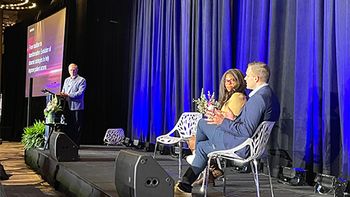
Unique Challenges to Market Access for Ophthalmology Biosimilars
Catherine Humphries sheds light on three key market access challenges within the ophthalmology biosimilars space.
As we watch a tense biosimilars drama play out on the world stage, there’s an interesting play-within-a-play happening within the ophthalmology space. The first ophthalmology biosimilar to Lucentis, BYOOVIZ, is anticipated to launch this summer, and there are many more in development, including biosimilars for Avastin and Eylea. While the ophthalmic biosimilars have the potential to alleviate financial burden—depending on the discount for the products compared to the originator brands and off-label Avastin—there are challenges that may slow adoption. Those entering this space will need a firm grasp on how this shifting market is likely to impact patient access.
To gain a better understanding of the increasingly complex dynamics within this emerging market, key findings from MMIT’s latest Biologics and Injectables Index1 sheds light on three key market access challenges within the ophthalmology biosimilars space.
Challenge #1: Lack of biosimilar data
Prescribers have begun to express concern over lack of data for the biosimilars for Avastin,2 which is an important predictor for biosimilar adoption. The US will be the first country other than India to launch an ophthalmology biosimilar. In oncology and rheumatology, providers had access to more than 15 years of combined, global real-world data for those biosimilars prior to launching them in the U.S. In contrast, providers have years of data supporting efficacy and safety for the current standard of care, anti-VEGF therapy. Plus, current brands have FDA approval for one to five retinal indications, including Lucentis (Genentech/Roche, ranibizumab) with five indications; Eylea (Regeneron, aflibercept) with four indications; Beovu (Novartis, brolucizumab) with one indication; and off-label use in ophthalmology for compounded Avastin (Genentech, bevacizumab).
Additionally, off-label use of Avastin is prevalent. Safety and efficacy are backed by several years of data, as one of the most commonly used anti-VEGF agents in age-related macular degeneration, with a cost of approximately $50 per injection compared to between $1,800 and $2,000 per injection for the branded competitors. How the ranibizumab biosimilar is priced, including discounts and rebates, will be key in determining how payers will position the biosimilar compared to other options.3
Challenge #2: Provider hesitancy
Some providers are taking a more cautious stance on biosimilars given the large amount of data supporting the use of the current standards of treatment. Recently, the American Academy of Ophthalmology (AAO) released a statement urging CMS to prohibit insurance companies from requiring ophthalmologists to use new biosimilar drugs as alternatives to Avastin for treatment in eye diseases.4 The AAO is not opposed to the use of the new biosimilars or the use of drugs off-label in general. Rather, they are opposed to the use of drugs in the eye that have never been tested for ophthalmic diseases. Due to a major Avastin supply issue, large insurers including Aetna, CareFirst, United Healthcare, Humana, Horizon Blue Cross Blue Shield of New Jersey, AmeriHealth and Health Assurance Pennsylvania have recommended or mandated biosimilar alternatives, according to the AAO. Ophthalmologists are concerned that a buffering agent that’s used in a biosimilar to Avastin that has not been studied could cause toxicity.5
Challenge #3: Options for payers
Our research shows that payers within the Medicare channel are likely to manage biosimilars separately from branded products as soon as one biosimilar is available, whereas some payers within the commercial channel anticipate waiting until there are two biosimilars available. Payers surveyed for both channels noted that they anticipate provider hesitancy and pushback on transitioning to biosimilars due to gaps in knowledge about the safety and efficacy of the biosimilars.
Plus, clinical research in ophthalmology has steadily produced new data supporting existing and pipeline products. Most recently, in January 2022, the FDA approved Genentech’s Vabysmo (faricimab), the first bispecific antibody designed for intraocular use that targets two different pathways of retinal disease.
Then there are the “bio-better” products: While biosimilars have the same amino acid sequence and are highly similar to the reference products, bio-betters may be modified chemically and have a different amino acid sequence or purification process. This can improve shelf life and pharmacological effects. Alteogen has patented an aflibercept biosimilar formulation that has an improved shelf life and resistance to heat. There’s also Genentech's Susvimo, which offers an alternative to the monthly injections using a port system that can deliver ranibizumab continuously and is refilled during an outpatient office procedure twice yearly.6
Moreover, with patients preferring less frequent dosing due to the route of administration for the anti-VEGF products being intravitreal (eye) injections, we could see payers lean toward existing options. Currently the anti-VEGF treatments require injections every one to two months (following initial injections). Trials are currently ongoing for a high-dose formulation of Eylea to evaluate longer duration between doses.
Overcoming the challenges
While payers anticipate that the entry of the biosimilars could reduce costs for the expensive branded anti-VEGF products, adoption by prescribers may be slow in the ophthalmology market. The currently trusted, low-cost alternative of Avastin off-label use and possible contracting for branded anti-VEGFs are barriers to the uptake of the biosimilar products. It will continue to be a market to monitor closely as the clinical research is anticipated to reveal better alternatives for patients.
Catherine Humphries is a Senior Consultant at
References
https://www.mmitnetwork.com/biologics-injectables-index/ https://www.retina-specialist.com/article/five-things-to-know-about-biosimilars-in-retina https://www.reviewofophthalmology.com/article/first-ranibizumab-biosimilar-approved https://www.centerforbiosimilars.com/view/ophthalmology-group-opposes-payer-recommendations-for-bevacizumab-biosimilars https://www.managedhealthcareexecutive.com/view/ophthalmologist-group-wants-u-s-government-to-push-back-against-avastin-biosimilars https://journalretinavitreous.biomedcentral.com/articles/10.1186/s40942-021-00343-3
Newsletter
Stay ahead in the life sciences industry with Pharmaceutical Commerce, the latest news, trends, and strategies in drug distribution, commercialization, and market access.




